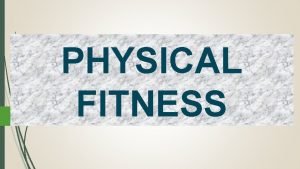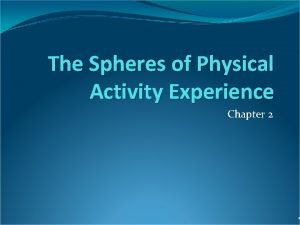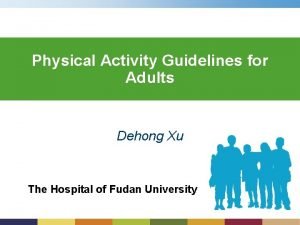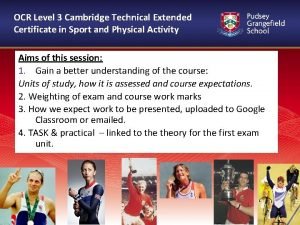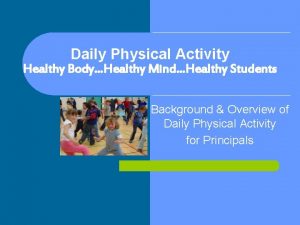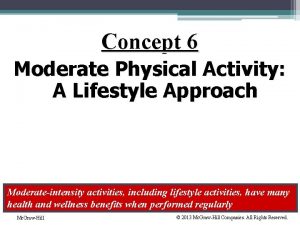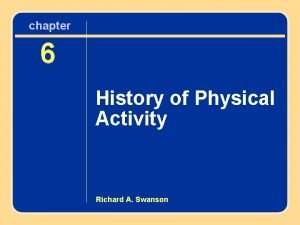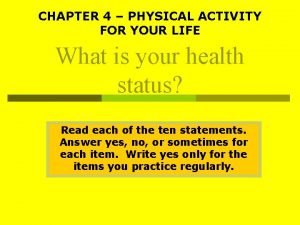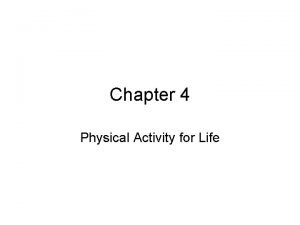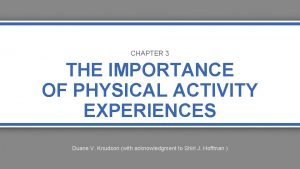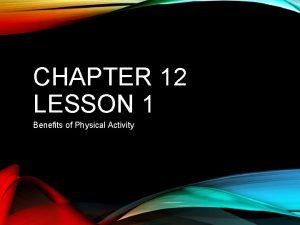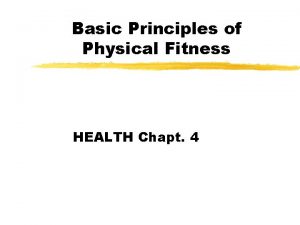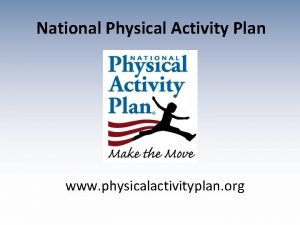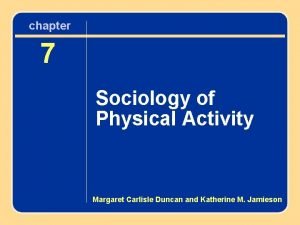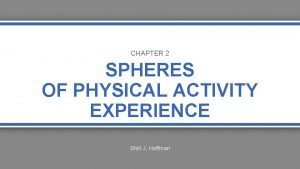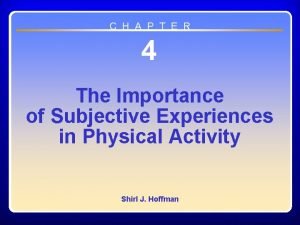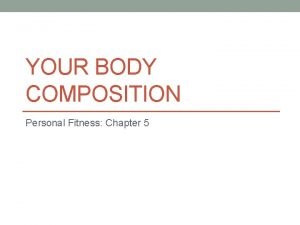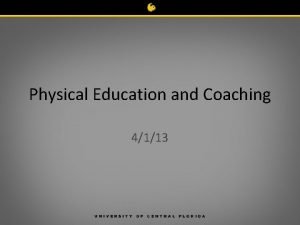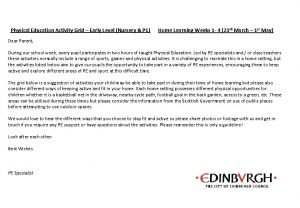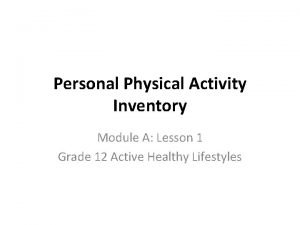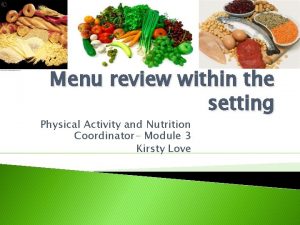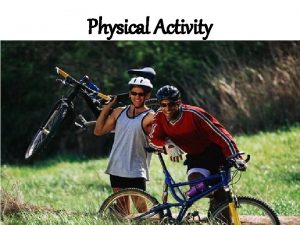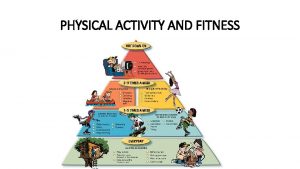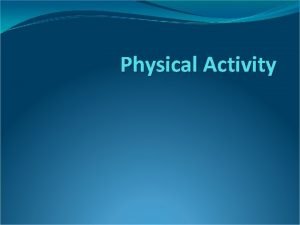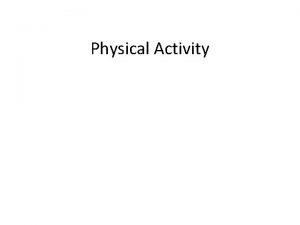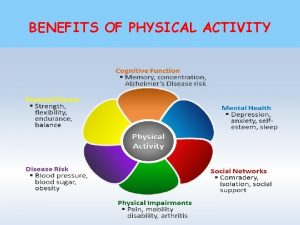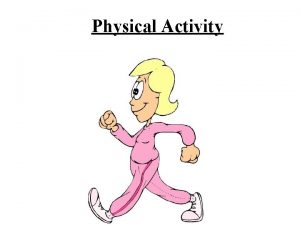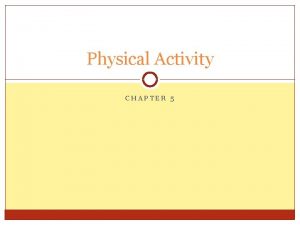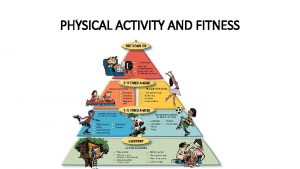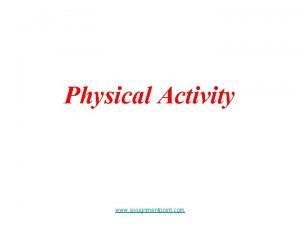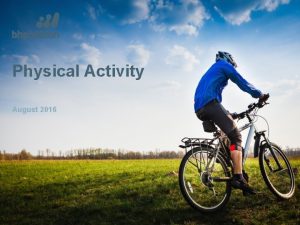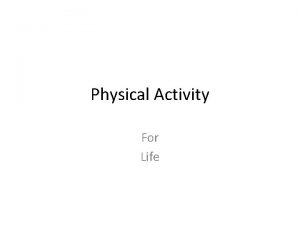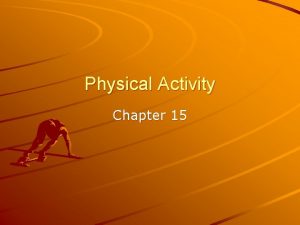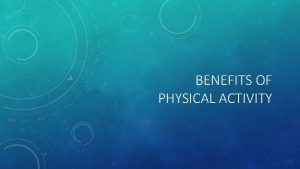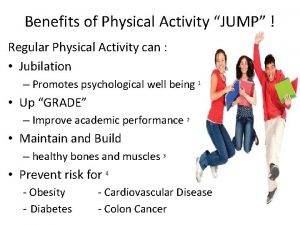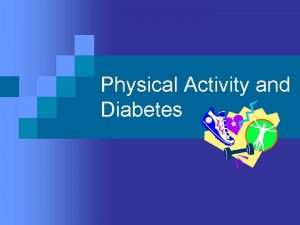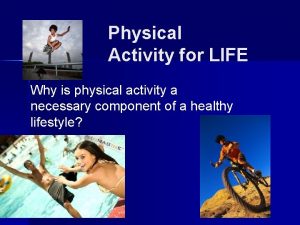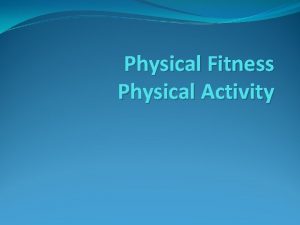What is Physical Activity Physical Activity is defined





































- Slides: 37

What is Physical Activity ? Physical Activity is defined as any bodily movement created by the skeletal muscles resulting in energy expenditure. This can include any activity that we do – and is not restricted to formal structured activities or exercise like football or aerobics. Walking the dog, DIY, household chores and gardening all count as physical activity. 2

Why promote Physical Activity ? There has been a significant increase in obesity in the UK and that, combined with a decrease in the number of people doing the recommended amount of exercise, has resulted in a renewed focus in encouraging people to be more active. For your clients, the role of activity in pregnancy is to prepare their bodies for the physical exertion required during labour, but also to improve their health, minimise their weight gain during pregnancy by using energy and to develop good habits for when their baby is born and they can begin to work on losing their excess weight. 3

Obesity and the impact of physical activity • Obesity occurs when a person’s energy intake exceeds their energy output. In other words, they eat more foods/energy than they are using in the activity that they do. • The Energy Balance has two sides: • On the one side you have energy in (food – i. e. protein, fats and carbohydrates) • The other side is energy out (both for daily movement and physical activity). 4

Energy Balance A positive energy balance means that the amount of energy (food) consumed is greater than the amount of energy used in daily activity. In this situation = WEIGHT IS GAINED 5

Energy Balance A negative energy balance occurs when the amount of energy consumed is less than the amount of energy used in daily activity. In this situation = WEIGHT IS LOST 6

Energy Balance A neutral energy balance is where the amount of energy consumed is equal to the amount of energy used in daily activity. In this situation = WEIGHT IS MAINTAINED 7

Environmental Influences There has been some suggestion that it is partly the environment in which we live, rather than our own responsibility for actions (or inactivity) that has contributed to the increase in obesity. It is clear that genetics do play a part in that one person might be born with a stronger tendency to gain weight than another. However, it is this genetic tendency, combined with other factors that results in weight being gained. One example is the significant increase in the availability of food – particularly high fat and high calorie foods. In addition, due to working patterns, car usage and technology physical activity has decreased. 8

Environmental Influences These changes to environmental influences have resulted in the term “obesogenic environment” to describe the place we now find ourselves. It describes the social factors that have influenced the so called ‘fat epidemic’. ‘We live in an obesogenic environment – a plethora of fast food outlets, reliance on cars, and offers enticing us to eat larger portions …’ Professor Mike Kelly – as quoted in the Telegraph 8 th October 2003 The Healthy Weight, Healthy Lives Strategy, combined with the Change 4 Life campaigns are both targeted at reducing the impact of the environment on obesity. 9

NHS Physical Activity Message The NHS has developed clear messages around what the recommended amount of activity is for both adults. The original message focused on vigorous exercise because, at that time, evidence suggested that had clear benefits to heart health. NHS recommendations at that time were for adults to do 3 20 minutes vigorous exercise every week. This has now changed to reflect a better understanding of what makes out bodies work most effectively. The current NHS message is 5 x 30 minutes of moderate activity every week. In addition, clients should be encouraged to do activities to promote bone health, muscle strength and flexibility 2 times a week. Any activity done for 10 minutes or more counts towards the 30 minute target. 10

Key Principles of the Message Vigorous Activity Heart beats rapidly, breathing hard. Includes activities such as running, jogging, squash, swimming, rapidly, cycling, basketball, aerobics Moderate Activity Breathing harder than normal and feeling warmer. Includes activities such as brisk walking, tennis, badminton, swimming, line dancing, heavy gardening-digging/mowing, heavy housework-washing floors/windows. Mild Activity Minimal effort, very easy. Includes activities such as yoga, easy walking, light housework or gardening, bowls 11

Key Principles of the Message The classification of the activity depends on the impact on the person doing it – for example, if someone rarely odes any activity and a walk to the park for 15 minutes leaves them breathing hard and their heart beating rapidly, this could be classed as a vigorous activity. Alternatively, for someone who is frequently active, they may take part in a high paced game of squash, which for most others would be a vigorous activity but leaves that person only slightly out of breath – it would be a moderate activity for them. 12

Key Principles of the Message § Benefits Health § Frequency Everyday(minimum of 5 days a week) § Intensity Moderate e. g. brisk walking § Time Accumulate 30 minutes i. e. can be done in episodes of 10 -15 minutes § Type Anything from formal/structured activity to informal lifestyle activities (such as walking, cycling, manual labour and gardening) 13

Benefits of Physical Activity The benefits of physical activity are wide ranging – from actual physical health benefits in heart and lung health to impacts on preventing later health conditions and wider well being. Consider the benefits of physical activity – post onto the forum your thoughts. Try to include at least one example of benefits in each category: • Social • Emotional • Physical 14

Benefits of Physical Activity There is substantial evidence identifying the benefits of physical activity: § Support weight loss (in conjunction with diet control) § Prevention and management of obesity and diabetes § Reduced risk of coronary heart disease, stroke and hypertension § Reduced risk of some cancers § Improved blood lipid profile § It is estimated that 33% of all CHD, 25% of strokes and Type 2 diabetes could be avoided with regular physical activity (HEA, 1995) 15

Benefits of Physical Activity § Improve functional capacity – this means how we feel/perform and are able to operate on a daily basis. The more active we are, the better we will feel (eventually). § Reduced risks of osteoporosis § Improved mental well-being § Reduced and better management of stress § Positive impact on reducing and preventing depression § Reduced risk of lower back pain § Improved sleeping habits § Feeling more energetic § Help clients to feel more positive about themselves / improved self esteem 16

Benefits of Physical Activity • better health • more energy • improved body shape • reaching and maintaining a healthy weight • more social opportunities • a sense of achievement • more independence in later life § better balance, strength, suppleness and mobility § stronger bones and muscles 17

Consequences of Inactivity There are obviously clear benefits of activity to health and well being. The most significant impact for our clients is that inactivity will inhibit their ability to lose weight – they need to be active to burn energy. There also clear links between inactivity and impact on health and not only in increasing obesity but other serious health conditions. Leading causes of disease and disability associated with physical inactivity are: 1. Coronary Heart Disease (CHD) 2. Stroke 3. Obesity 4. Type II Diabetes 5. Hypertension 18

Inactivity as a major risk factor 19

Barriers to physical activity Despite there being clear benefits, many people struggle to increase the level of activity they do and most adults do not meet the NHS recommended amount each week. Refer to the Barriers to Physical Activity exercise and the Physical Activity Case Studies before continuing. 20

Potential Barriers to Activity § Lack of knowledge and information about how they could benefit from becoming more active § Lack of time often due to other priorities (e. g. work and family commitments, other social or leisure options) § Lack of an exercise partner or social support § Not the ‘sporty type’, lack of perceived required skills § Financial Constraints § Lack of available – or welcoming facilities § Lack motivation or willpower § Don’t enjoy activity § Embarrassment or fear of the unknown 21

Overcoming Barriers There a number of solutions to most of the barriers presented by clients. Consider the case study examples, barriers identified were around equipment or time available. But, the real reason, may actually have been motivation, energy, or embarrassment. Questioning the client and understanding their current activities will help you to support them to increase activity. • Have they ever been active? What did they do? How did it used to make them feel? Why did they stop? • Ask about what they would like to do – then look at what their barriers to that are • Help them to think about how they can be more active themselves. • Your role is to help them explore their barriers – and find the true issue. • Then, your role is to support them to identify a solution. 22

Attitudes towards Physical Activity 23

Physical Activity during pregnancy Staying fit during pregnancy helps women cope better with the physical demands of: § Pregnancy – by offsetting constipation, tiredness and circulation problems § Labour – by building muscle tone, strength and § stamina For some women, during their pregnancy they feel at their healthiest and can be more motivated to be active. Other women may find it more tiring or less able to be active. For those women, exercise may help by boosting energy levels as well as their immune system 24

Physical Activity during pregnancy Being active during your pregnancy can also reduce the physical discomforts of: • Backache • Constipation • Fatigue • Swelling • It can improve mood and self-image • It can even help a client to sleep more soundly. • It can also help the body cope with pregnancy weight gain 25

Physical Activity during pregnancy How much? This depends on how fit the woman was before becoming pregnant. The general guidance is that is safe for them to continue doing the activities they did prior to becoming pregnant – with some exceptions which we will cover later. They should wear loose, comfortable clothes, drink plenty of fluids and avoid becoming too hot/overheated as this can be harmful for the baby. They should take a gentle approach to avoid stretching or straining muscles/joints. 26

Physical Activity during pregnancy Women should be encouraged to start any activity with a gentle warm up. This should take at least 10 minutes. Recommend a gentle approach to any exercises that put strain on joints and ligaments. Pregnant women should be working at ‘moderately hard’ level. At the end of the exercise session, women should take time to cool down slowly –exercise should never suddenly stop as this can cause them to feel dizzy/faint as the blood continues to be pumped quickly around the body. 27

Physical Activity during pregnancy Women should listen to their bodies. Dizziness and fatigue is not uncommon in the first 12 weeks or so, and some women lose their balance later on as the baby grows and their centre of gravity shifts. You must stop and consult your health care provider immediately if you experience: § dizziness, or headaches, § chest pains, or heart palpitations (when you notice an irregular heartbeat), § severe, or rapid swelling of your hands, feet, or face, § vaginal pains, bleeding, or contractions § difficulty walking. If they can’t talk easily while exercising, they’re overdoing it, and need to slow down. 28

Activity to avoid during pregnancy § Participation in any contact sports or any activity with a potential for hard falls, such as horse riding should be avoided (unless you are a very experienced rider) § No exercise flat on your back, particularly after 16 weeks, should be performed as the baby may press on big blood vessels and can cause pregnant women to feel faint. § Saunas/steam rooms should be avoided as it risks overheating the baby. 29

Physical Activity during pregnancy Physical activity for some women is not recommended during pregnancy. Refer to the midwife or doctor if the woman has a history of: § multiple miscarriages, § ruptured membranes (waters breaking), § early labour, or § weak cervix. 30

Physical Activity during pregnancy You should also seek advice from your wider support team if the woman has: • had a threatened miscarriage • had a previous premature baby • knows that she is at risk of premature labour this time • knows that she has a low lying placenta • has had significant bleeding • has had problems with your lower back or hip joints • has a pre-existing medical condition • has very high blood pressure • is expecting more than one baby 31

Considerations Raised Hormone Levels (Difiore, 2000) There are 3 hormonal changes in pregnancy that influence the way pregnant women should exercise • Relaxin – softens the connective tissue in joints and muscles enabling the pelvis to widen for delivery and the abdominals and the pelvic floor muscles to stretch. During pregnancy, this results in joint instability and an increased risk of injury. • Oestrogen – the growth hormone that causes breasts to enlarge and increased the strength and size of the heart. It also encourages water retention. During pregnancy, results in swollen ankles, heartburn • Progesterone – relaxes the walls of the blood vessels to enable them to cope with the increased volume of blood. It also increases body temperature. During pregnancy contributes to overheating and dizziness 32

Recommended Activities Walking has been proven to net the same health benefits as jogging or running and is one of the only physical activities that can be participated in that is completely free of charge, requires no specialised clothing or footwear and can be participated in as an individual or as a group. Fresh air can also help combat morning sickness. § § Stay on ground that is level. Wear supportive shoes. Don't walk during the hottest part of the day. Carry water with you and drink it regularly. 33

Recommended Activities Aerobics is great for the heart and lungs as well as improving muscle tone. By sticking to low-impact routines, women should be able to continue for as long as they feel able. Women should try to find a class designed for pregnant women – aqua aerobics (aquanatal) helps support the body during pregnancy. If these are not available, they should tell their instructor who will advise which activities to avoid during the session. Long periods of standing in one position can lead to a drop in blood pressure and cause dizziness particularly after 13 weeks. • Wear cool clothing and plenty of water. • Avoid using steps – or if you do, ensure it is lowered • Avoid jumps and sudden changes in direction 34

Recommended Activities Yoga is great for working muscles without too much impact on joints. Most of the breathing techniques used in yoga are a good preparation for childbirth, helping women to remain calm and breathe steadily through contractions. Yoga also improves posture, which will help with back pain and can increase flexibility, to make birthing positions such as squatting easier. Women should try to attend a specialist pregnancy yoga session as some positions and breathing exercises will not be appropriate in pregnancy. If this is not available, tell the women to inform the instructor that they are pregnant. 35

Recommended Activities Running For an experienced runner there are many benefits from running during pregnancy. It's an unbeatable cardiovascular workout which can be as long or as short as they can manage. But pregnancy is not the time to start running; walking is a safer option. Running can be tough on joints and as the hormone relaxin loosens the joints there is a greater chance of injury. In weeks 13 to 28 they may feel at their most energetic, but as their pregnancy progresses, they should take less intense runs and more care and consider a shift to swimming or walking in the last three months. • • Wear supportive shoes. Drink lots of water. Don’t run in the eat. Run on even ground. 36

Recommended Activities Swimming has several benefits, from improved circulation and better muscle tone to increased endurance. Ideally, clients should aim for 30 minutes, three to four times a week. It's important to find a stroke that they find comfortable and to avoid busy periods at the pool. Many pools run a range of antenatal swimming classes. As they move into their final three months the weightlessness that comes with water will be very comfortable, and client’s can continue swimming throughout pregnancy. While other exercises involve an increased risk of injury due to the loosening of ligaments and joints in pregnancy, swimming doesn't as the body is supported by the water. 37

Try it Yourself Have a look at the ‘Being Active’ activity and consider completing it before continuing onto Activity after Pregnancy. 38
 Well defined set
Well defined set Physical fitness grade 9
Physical fitness grade 9 Ability to do strength work at an explosive pace
Ability to do strength work at an explosive pace Activity 2 limiting reactants activity
Activity 2 limiting reactants activity Activity coefficient
Activity coefficient Aon and aoa network diagrams examples pdf
Aon and aoa network diagrams examples pdf Activity 1 introductory activity
Activity 1 introductory activity Activity 2 finding the sequence
Activity 2 finding the sequence Activity 2 plus and minus
Activity 2 plus and minus 3
3 Spheres of kinesiology
Spheres of kinesiology Who global strategy on diet, physical activity and health
Who global strategy on diet, physical activity and health Moderate activity
Moderate activity Ocr level 3 sport and physical activity
Ocr level 3 sport and physical activity Moderate physical activity examples
Moderate physical activity examples Moderate physical activity
Moderate physical activity Between 1950 and 2000, physical activity professions
Between 1950 and 2000, physical activity professions Is a way of life that involves little physical activity.
Is a way of life that involves little physical activity. Chapter 12 lesson 3 planning a personal activity program
Chapter 12 lesson 3 planning a personal activity program Professional experience in physical activity
Professional experience in physical activity Fitness chapter 12
Fitness chapter 12 Chapter 12 physical activity and fitness
Chapter 12 physical activity and fitness Physical activity pyramid worksheet
Physical activity pyramid worksheet Chief medical officers physical activity guidelines
Chief medical officers physical activity guidelines Physical education during the age of feudalism
Physical education during the age of feudalism National physical activity plan
National physical activity plan Physical fitness definition
Physical fitness definition Sociology of physical activity focuses on
Sociology of physical activity focuses on Kind of physical activity
Kind of physical activity Seven spheres of physical activity
Seven spheres of physical activity Chapter 14 the physical geography of russia answers
Chapter 14 the physical geography of russia answers We are more likely to enjoy physical activity when
We are more likely to enjoy physical activity when Body composition, physical activity
Body composition, physical activity Definition of sport pedagogy
Definition of sport pedagogy Pe sals
Pe sals Physical activity inventory
Physical activity inventory Physical activity and nutrition coordinator
Physical activity and nutrition coordinator Glencoe health chapter 12
Glencoe health chapter 12


